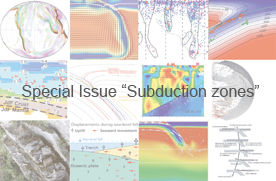Three-dimensional thermal structure of subduction zones: effects of obliquity and curvature
Abstract. Quantifying the precise thermal structure of subduction zones is essential for understanding the nature of metamorphic dehydration reactions, arc volcanism, and intermediate depth seismicity. High resolution two-dimensional (2-D) models have shown that the rheology of the mantle wedge plays a critical role and establishes strong temperature gradients in the slab. The influence of three-dimensional (3-D) subduction zone geometry on thermal structure is however not yet well characterized. A common assumption for 2-D models is that the cross-section is taken normal to the strike of the trench with a corresponding velocity reduction in the case of oblique subduction, rather than taken parallel to velocity. A comparison between a full 3-D Cartesian model with oblique subduction and selected 2-D cross-sections demonstrates that the trench-normal cross-section provides a better reproduction of the slab thermal structure than the velocity-parallel cross-section. An exception is found in the case of a strongly curved trench, such as in the Marianas, where strong 3-D flow in the mantle wedge is generated. In this case it is shown that the full 3-D model should be evaluated for an accurate prediction of the slab thermal structure. The models demonstrate that the use of a dynamic slab and wedge, separated by a kinematic boundary, yields good results for describing slab velocities in 3-D.






